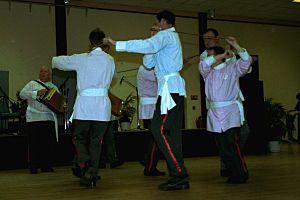Goathland Plough Stots facts for kids
| Classification | |
|---|---|
| Genre | Long Sword Dance |
The Goathland Plough Stots are a special team of Long Sword Dancers. They come from the village of Goathland in North Yorkshire, England. Their traditional dance had almost disappeared by the early 1900s. But it was brought back to life in 1922! This team was even asked to leave a group called the Morris Ring. This happened because they allowed girls and women to learn the dance. Traditionally, this dance was only for men. The Goathland Plough Stots dance is one of the oldest in England. Its history goes back more than a thousand years!
Contents
History of the Dance
The Long Sword dance is very old. It dates back to the time of the Viking invasions in England. The dance performed by the Goathland Plough Stots is one of the oldest of its kind. It has been around for over a thousand years! Other villages in the North Riding of Yorkshire also had similar long-sword dance groups. These included places like Egton, Flamborough, Sleights, and Staithes.
In the 1700s and 1800s, almost every village in the Eskdale area had a Long Sword dance team. Later, in the early 1900s, a man named Cecil Sharp visited this part of North Yorkshire. He was writing down traditional village dances and their music. However, he didn't write down the Goathland dance. He thought it was too much like the dance from Sleights. By the time he visited, only Sleights and Goathland still had their dance teams.
Plough Monday Traditions
The Goathland Plough Stots Dance started around a day called Plough Monday. This was usually the first Monday after Epiphany. The dancers used to wear either pink or blue tunics. The dance also came with a play. When the dance was brought back in 1923, the play was also revived. However, parts of the original play were changed. This was because some parts were considered a bit rude.
The dancers were called "Stots." Originally, "stots" meant the oxen that pulled a plough. Later, it became the name for the Long Sword dancers. The dancers would pull a plough through the village. They would jokingly threaten to plough someone's garden! This was unless people gave them money for the young dancers.
Characters and Collections
In the play, one older dancer would dress up as a woman, known as Betty. Another would dress up as an old man, called Isaac. They played the roles of a gentleman and a lady in the play.
When the dance was revived, the money collected was given to local hospitals. The Plough Stots would travel around the community for up to two weeks. They would dance and collect money. After this, they would have a big feast at a local inn. People believe that collecting money was originally meant to pay for new candles. These candles had been burned during the twelve days of Christmas. These days ended the day before Plough Monday. Also, the plough was blessed in a church service. This tradition continued in Goathland into the 21st century. Today, it happens in only a few churches.
Changes and Challenges
In the early 2010s, the Plough Stots realized their tradition might disappear. So, they started training females to learn the dance. This was a big change! Because of this, they were "excommunicated" from the Morris Ring. This group is a national association for men's Morris and Sword Dance Clubs. But, except for a short time during the Second World War, the Plough Stots have danced every Plough Monday since 1923.
Notable Members
- Eliza Carthy, a famous folk musician, joined the team as a fiddler when she was a teenager. She is from the Robin Hood's Bay area.


